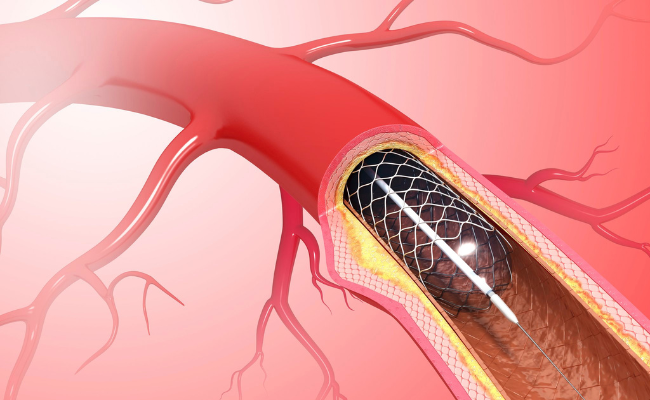Know about Angioplasty
- February 16, 2024
- No Comments

What is Angioplasty?
Angioplasty, also known as percutaneous coronary intervention (PCI), is a minimally invasive medical procedure used to open blocked or narrowed arteries. It is primarily performed to treat coronary artery disease (CAD), a condition characterized by the buildup of plaque (atherosclerosis) within the arteries that supply blood to the heart muscles. This plaque buildup can restrict blood flow to the heart, leading to symptoms such as chest pain (angina) or increasing the risk of heart attacks.
Why is Angioplasty Done?
Angioplasty is done for several reasons:
- Relief of Symptoms: One of the primary goals of angioplasty is to alleviate symptoms associated with CAD, such as chest pain (angina) and shortness of breath, by restoring proper blood flow to the heart muscles.
- Prevention of Heart Attacks: By opening blocked arteries, angioplasty reduces the risk of complete blockages that could lead to heart attacks, thereby improving overall cardiovascular health.
- Improvement of Quality of Life: Angioplasty can significantly enhance the quality of life for individuals with CAD, allowing them to resume normal activities and enjoy a better quality of life without the limitations imposed by their symptoms.
- Management of Acute Coronary Syndromes: Angioplasty is often performed as an emergency procedure in cases of acute coronary syndromes, such as unstable angina or myocardial infarction (heart attack), to restore blood flow to the heart and prevent further damage.
How Does Angioplasty Work?
During an angioplasty procedure, a specially trained interventional cardiologist inserts a thin, flexible tube called a catheter into the blocked artery through a small incision, typically in the groin or wrist. The catheter is guided to the site of the blockage using fluoroscopy, a type of real-time X-ray imaging.
Once the catheter reaches the blockage, a small balloon at the tip of the catheter is inflated, pushing the plaque against the walls of the artery and widening the artery to restore blood flow. This process is known as balloon angioplasty. In some cases, a stent—a small mesh tube—is placed in the artery to help keep it open after the balloon is deflated and removed. This is called stent placement or stenting.
Treatment Solutions for Angioplasty:
Several variations of angioplasty exist, each tailored to individual patient needs:
- Balloon Angioplasty: The standard form of angioplasty involves using a balloon to widen the blocked artery. This is often the initial step in the angioplasty procedure.
- Drug-Eluting Stent (DES): In this type of angioplasty, a stent coated with medication is placed in the artery to help prevent it from narrowing again. Drug-eluting stents release medication over time to inhibit the growth of scar tissue within the artery.
- Rotational Atherectomy: This procedure involves using a tiny, rotating device to shave off plaque from the artery walls, allowing better blood flow. It is typically used in cases where the plaque is particularly hard or calcified.
- Cutting Balloon Angioplasty: A special balloon with tiny blades is used to cut through the plaque, making it easier to widen the artery. This technique may be employed in cases where the plaque is resistant to conventional balloon angioplasty.
- Fractional Flow Reserve (FFR): FFR is a diagnostic tool used during angioplasty to measure blood flow through a specific artery, helping determine the need for stent placement. It provides valuable information to guide treatment decisions and optimize outcomes.
Benefits of Angioplasty:
Angioplasty offers several benefits to individuals with coronary artery disease:
- Improved Blood Flow: By opening blocked arteries, angioplasty effectively restores blood flow to the heart muscles, alleviating symptoms such as chest pain (angina) and shortness of breath.
- Reduced Risk of Heart Attacks: Angioplasty reduces the risk of complete blockages in the arteries that could lead to heart attacks, thereby improving overall cardiovascular health and longevity.
- Minimally Invasive: Angioplasty is a minimally invasive procedure that is typically performed using local anesthesia. Compared to traditional open-heart surgery, angioplasty carries a lower risk of complications and requires a shorter recovery time.
- Customized Treatment: Angioplasty procedures can be tailored to each patient's specific condition and anatomy, ensuring personalized care and optimal outcomes.
- Enhanced Quality of Life: For individuals living with coronary artery disease, angioplasty can significantly improve their quality of life by alleviating symptoms, restoring normal activities, and reducing the need for ongoing medication or interventions.
Comments (0)